
Wine Culture and Information since 2002 - Volume 22
 Wine Culture and Information since 2002 - Volume 22 |
|
Issue 85, May 2010 |
Contents |
|
|
New Ways of Buying Wine |
|
Of these hard times of economic crisis have been talked a lot. A subject involving anyone and which has involved everything, every economic and productive area has been affected by the effects of this crisis which it unavoidably brought up. Understanding whether this crisis is over - or just seeing some signs of restart - it is not easy: some believe it is over and therefore invite people to “spend” while exhorting to optimism, others are more prudent instead. In short, it seems no one knows what the future will bring. Then, there is real life where anyone - or better to say, most of people - is forced to face life on a daily basis and finally getting a real vision of facts. Wine, of course, is no exception in this, indeed, being today considered as a luxury good instead of a need, its consumption, and therefore its purchasing, is frequently considered as a low priority thing in life and therefore it becomes a “luxury” drink one affords as soon as possible, or at least, from time to time. We talked many times about this crisis which unavoidably affected wine trading. Although there have been signs of restart, consumers are still having some discomforts, in particular when it comes to prices. In these times, one has to choose whether to be happy in buying a “decent” wine, or to completely avoid buying wine. To tell the truth, it should be said there is a huge number of wines sold at honest prices, but it is also true in many cases the price of some wines is not justified in any way by the quality found in the glass. Moreover, it should be said a lot of wines sold at affordable prices are however characterized by a truly low quality, sometimes being at the limit of drinkability. Not all people can do “experiments” or buying on a trial and error basis. Sometimes, when one has to make a decision whether spending money on an unknown product sold at an affordable price, in doubt of drinking a wine of improbably quality, consumers decide not to take the risk. The market, aware of what it is happening, tries to satisfy the needs of consumers, by offering a wide selection of wines, from extremely cheap ones to extremely expensive ones. One should enter a mall and take a look at the area dedicated to wine. Most of the times there are whole sections where only wine bottles are found, of which, most of them, sold at affordable prices. In this sense, supermarkets and malls have become the direct competitors of wine shops, that is those shops where wine is traditionally bought. It should be said, in regard to supermarkets, wine shops offer the added service of “counseling”, as here it is usually found qualified personnel who can give advices about any wine. It should also be said similar professional figures are becoming more and more popular in supermarkets too, found in sectors dedicated to wine, available to give an advice about the right wine for every occasion and, in particular, for every wallet. Although supermarkets are one of the places in which consumers frequently buy wine, in recent times a new trend is becoming more and more popular: buying wines directly from the producer. The advantages of doing so are sometimes interesting and convenient. First of all, it is possible to know the place of origin of wines - in this sense one can improve his or her culture - moreover, wines are usually sold at a more convenient price. It should be said differences in prices - for obvious reasons of competitions with conventional commercialization - are not substantial and far from normal prices, however sometimes one can get a considerable save of money. The purchasing of wines directly from the producer also offers another advantage over the other forms of purchasing: evaluating and tasting the wine before buying. This “advantage” represents the highest expression of honesty and loyalty: first you taste a wine, then, if you like it, you can buy it. Like to say, satisfied on every purchase. Purchasing the wine at the winery is also a good occasion for a trip with friends, going to the places of wine, understanding the quality of the territory and its grapes, as well as knowing the history of a winery, directly told by the one who makes that wine. For wineries this means having a direct contact with their customers, while letting them to visit the winery and generally having a more clear and direct relation. Going to the winery also gives another advantage: buying bulk wine - of course, the one which can be sold in this form by law - usually sold at low prices, with a “decent” and “worthy” quality according to the price. Not everyone can of course go to wineries, in particular the ones being far from the place in which one lives in. This problem is usually solved by the so called “group buying”, that is groups of friends and consumers who place an order for their wines directly to the producer, who, in turn, ships the wines directly to the client. In this case shipping cost can make the difference and could vanish the possible saving of money, but it is right in this case the efficiency of “group buying” can be very convenient. A group buying usually place an order of many bottles and therefore shipping costs marginally affect the price of each bottle. Will group buying be the new way of purchasing wine, while trying to have a more direct relation - and last but not the least, convenient - relation with the producer? By considering what it is going on in the world of wine, it seems this form of purchasing is getting more and more important. Also a poll of ours about this subject reveals this form of purchasing is one of the favorite ones among wine lovers. The choice of purchasing a wine directly from the producer it is not only determined by the lower availability of money and crisis. Consumers, maybe, are getting more and more conscious about the fact there have been many who simply exaggerated on this, by speculating and raising prices, in particular on those wines having a pretty disappointing quality and far from their price. Nobody is stupid, and in case of doubt - crisis or not crisis - the temptation of seeing how things are for real is pretty strong. And also justified.
|
||||
Comparing Soave Classico and Collio FriulanoThe two most famous white wines of Veneto and Friuli Venezia Giulia in a comparative tasting. Garganega and Friulano the grapes used for the production of these two prestigious Italian wines |
|
Veneto and Friuli Venezia Giulia, despite the two regions are bordering one to each other, keep their own viticultural and wine making traditions. The reasons are of course associated to the differences of the territory, as well as local traditions consolidated in the course of centuries. In these differences are however found common characteristics, at least in the styles produced, as in both regions viticulture is oriented both to white and red berried varieties. It is not by chance each region has renowned representatives both in white and red wines, frequently produced with autochthonous grapes, found both in Veneto and in Friuli Venezia Giulia. The most famous autochthonous white berried grapes of the two regions are Garganega for Veneto, Friulano for Friuli Venezia Giulia, few years ago known with the name of Tocai Friulano.
|
Soave has always been the most famous white wine from Veneto. In past times, together with few other wines, it was considered, in foreign countries, the most representative Italian white wine. Times have then changed as well as the destiny of Soave. This famous white wine from Veneto has followed, like to say, the destiny of Italian wine making, passing from a period in which it was quantity to represent the main presupposition, up to modern changes and trends based on quality. If it is true once Soave was considered as an “ordinary” wine, today it has reached very high quality levels, also thanks to the efforts of producers and the use of quality viticultural and wine making techniques. To this should also be considered the enterprising spirit of many producers who created different styles, from lively and immediate wines, aged in inert containers, to the most robust and complex ones, produced with overripe grapes and aged in wood containers. As for the composition of Soave Classico, the production disciplinary provides for the use of Garganega grape for at least 70%, whereas the remaining part can be represented by Trebbiano di Soave, Pinot Blanc and Chardonnay. In the remaining part can also be used - for a maximum of 5% - other white berried and non aromatic varieties authorized and recommended in the province of Verona. Despite production disciplinary allows the use of different varieties, today producers are mainly focused on the use of the autochthonous Garganega only, a variety being capable to prove - as opposed to the other varieties - its quality and elegance. Soave is generally vinified in inert containers - steel or cement tanks - in order to favor the qualities of fruits and flowers of Garganega. Good results have also been produced with the fermentation and aging in wood, therefore obtaining more robust and long-living wines, in which can be found complex sensations.
|
||||||||
|
Friulano - today are still many to call this grape with the old and traditional name Tocai Friulano - represents the soul and tradition of wine making in Friuli Venezia Giulia. After a long - and for certain aspects incredible - legal battle against Hungary, which claimed the exclusive use of the name “Tocai” for the famous wine of the homonymous area, it was necessary to change the name of the historical white berried grape, by eliminating the first part of the name - subject of the battle - while leaving the second part only, that is “Friulano”. The name has changed but the grape remains the same, a grape which was, and continues to be, one of the most important resources for wine making in this region, capable of making interesting and valuable wines. Friulano certainly is the most common white berried grape in Friuli Venezia Giulia and in the course of its history - the presence of this grape in the territory is long of centuries and widely documented - has represented both the daily habit of a good glass of wine as well as quality products. Collio is the great white wines land of Friuli Venezia Giulia and, despite here are being cultivated international varieties as well, Friulano has been the white berried grape which mainly identified the region in Italy and in the world, not only for the name which directly associates the grape with its land, but also for its wines. The recent history of Friulano has been characterized not only by a qualitative improvement of wines, but also by an interesting activity of experimentation, trying to understand the potentialities of the grape. Friulano is traditionally vinified by using inert containers - steel and cement tanks - however also the technique of fermenting and aging in cask or barrique has been frequently used for its wines. Although the name of the grape has been changed because of legal reasons, Friulano has always proven to be a great grape for the production of white wines, in which the good body is added to crispness and elegance.
|
||||
|
Garganega and Friulano are two interesting grapes capable of making excellent wines in the respective areas of origin. For our comparative tasting, despite the versatility of the two grapes, we have chosen two wines fermented and aged in inert containers, in both cases in steel tanks. The first wine of our comparative tasting is Ca' Rugate's Soave Classico Monte Fiorentine, produced with 100% Garganega and aged in steel tanks. The second wine of the tasting is Schiopetto's Collio Friulano, historical producer of Friuli Venezia Giulia, produced with 100% Friulano, aged for about 8 months in steel tanks. For both wines will be used the most recent vintages commercialized by respective producers. As for the service, the wines will be poured in two ISO tasting glasses at a temperature of 10°C (50°F), a temperature suited for appreciating crispness and youth of both wines.
|
|
The aspect of white wines is, first of all, characterized by a high transparency, a quality which is also found in Collio Friulano and Soave Classico. The color of these wines is pretty similar and of course depending on the production techniques. In their youth can be observed a brilliant greenish yellow color as well as straw yellow, with nuances of the same color. The fermentation and the aging in wood - both in barrique and cask - contribute to deepen color, giving these wines an intense and brilliant golden yellow hue. It should however be said both Soave Classico and Collio Friulano are generally fermented and aged in inert containers, frequently in steel tanks. Garganega and Friulano - produced with quality viticultural techniques - allow the production of wines having a good body, therefore pretty longeval, hence allowing the aging in bottle for some years. In these cases the color gets the typical intense and deep golden yellow color. The first wine we will evaluate in this first phase of the tasting is Ca' Rugate's Soave Classico Monte Fiorentine. By holding the glass tilted over a white surface, let's observe the base of the glass in order to appreciate color. It will be observed a pale brilliant and intense straw yellow color, as well as a high transparency. Let's now observe the wine at the edge, towards the opening of the glass, in order to evaluate nuances. Here it can be observed a greenish yellow color, a clear sign of the youth of wine. Let's now pass to the evaluation of Schiopetto's Collio Friulano. The color of this second wine is not so different from the previous one. Also here can be observed a pale brilliant and intense straw yellow color, with a very high transparency. As a confirmation of the young age of the wine, just like the previous one, the color of nuances is greenish yellow.
|
|
Both Garganega and Friulano make wines with interesting olfactory profiles, both characterized by sensations of fruits and flowers. Among the many aromatic qualities of wines produced with these grapes, one in particular is found in both varieties and in both is considered as a characteristic quality: almond. This particular aroma is not always perceptible in the opening phase, it can also be perceived after having properly swirled the glass. Among the typical aromas of Garganega are mentioned apple, pear, peach, hawthorn and broom, however can also be found sensations recalling tropical fruits, such as pineapple. Also in the olfactory profile of Friulano we can find apple, pear and peach, as well as plum, pineapple and citrus fruits. As for flower aromas, in Friulano is frequently found hawthorn, broom, chamomile and - rarely - acacia. The first wine of which we will evaluate olfactory profile is Ca' Rugate's Soave Classico Monte Fiorentine. By holding the glass in vertical position and without swirling, let's proceed with the first smell in order to appreciate opening aromas. From the glass will be appreciated intense and clean aromas of apple, plum and hawthorn, as well as a pleasing aroma of almond, typical in wines produced with Garganega grape. After having swirled the glass - therefore favoring the development of other aromas - let's proceed with the second smell which will allow the perception of the aromas of pear, pineapple, peach, citrus fruits, broom, chamomile and a pleasing hint of mineral. Let's now pass to the evaluation of Schiopetto's Collio Friulano. By holding the glass in vertical position and without swirling, the first smell will allow the perception of the opening of apple, pear and peach, as well as the typical almond aroma. After having swirled the glass, the aromatic sequence is completed by plum, pineapple, hawthorn, broom and a pleasing hint of elder.
|
|
Wines produced with Garganega and Friulano are generally characterized by a good body and a good volume of alcohol. Despite acidity is a main quality in both wines, in those made from Friulano this characteristic seems to be more prominent that in Garganega wines. Wines produced with Garganega tend to have a higher roundness and smoothness that, in this sense, help to reach acidity's balance. Of the two, Friulano is the one giving wines with a fuller body. The two wines are generally characterized by a pretty high alcohol by volume, sometimes higher than 13.5%, a pretty considerable value if compared to the average value generally found in white wines. Also alcohol plays a fundamental role in reaching balance, in particular of acidity that - like already said - it is a primary quality in both wines. We will begin with the tasting of Ca' Rugate's Soave Classico Monte Fiorentine. The attack of this wine is characterized by a pleasing crispness - a quality caused by acidity - followed by roundness, not excessive, but however pleasing and perceptible, as well the roundness produced by alcohol. It should be noticed the good correspondence to the nose, in particular apple, plum and almond, well perceptible during the evaluation of persistence. In the finish can be perceived the flavor of almond, a quality very frequent in wines produced with Garganega. Let's now pass to Schiopetto's Collio Friulano. Also in this case the attack is dominated by the crispness produced by acidity, more evident than the previous wine, and also the sensation of body is more evident than the previous wine. The contribution of alcohol plays in this wine a fundamental role in balance. Also in this wine the correspondence to the nose is very good - apple, pear and almond - as well as persistence, which leaves in the mouth the typical flavors of almond.
|
Wines of the Month |
|
|
|
Score legend Prices are to be considered as indicative. Prices may vary according to the country or the shop where wines are bought |
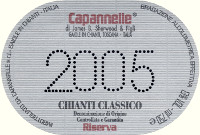
|
|
Chianti Classico Riserva 2005 |
|
| Capannelle (Tuscany, Italy) | |
| Grapes: Sangiovese (90%) Colorino, Canaiolo (10%) | |
| Price: € 30.00 | Score: |
| This Chianti Classico Riserva shows an intense ruby red color and nuances of ruby red, little transparency. The nose denotes intense, clean, pleasing and refined aromas which start with hints of plum, black cherry and violet followed by aromas of blueberry, blackberry, vanilla, tobacco, licorice, cocoa, cinnamon and menthol. The mouth has good correspondence to the nose, a tannic attack and however balanced by alcohol, good body, intense flavors, agreeable. The finish is persistent with flavors of black cherry, plum and blueberry. This Chianti Classico Riserva ages for 18 months in cask. | |
| Food Match: Roasted meat, Stewed and braised meat, Hard cheese | |
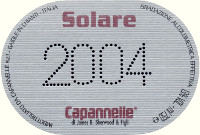
|
|
Solare 2004 |
|
| Capannelle (Tuscany, Italy) | |
| Grapes: Sangiovese (80%), Malvasia Nera (20%) | |
| Price: € 55.00 | Score: |
| Solare shows an intense ruby red color and nuances of garnet red, little transparency. The nose reveals intense, clean, pleasing, refined and elegant aromas that start with hints of black cherry, plum and violet followed by aromas of blackberry, blueberry, black currant, vanilla, tobacco, mace, licorice, chocolate, leather and menthol. The mouth has good correspondence to the nose, a tannic attack and however balanced by alcohol, full body, intense flavors, agreeable. The finish is persistent with flavors of black cherry, plum and blackberry. Solare ages for 14 months in barrique. | |
| Food Match: Game, Roasted meat, Braised and stewed meat, Hard cheese | |
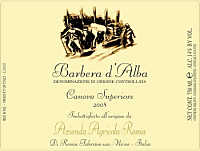
|
|
Barbera d'Alba Superiore Canova 2008 |
|
| Ressia (Piedmont, Italy) | |
| Grapes: Barbera | |
| Price: € 14.00 | Score: |
| Barbera d'Alba Superiore Canova shows a brilliant ruby red color and nuances of ruby red, little transparency. The nose denotes intense, clean, pleasing and refined aromas which start with hints of cherry, plum and blueberry followed by aromas of violet, vanilla, raspberry, chocolate, pink pepper and menthol. The mouth has good correspondence to the nose, a tannic attack and however balanced by alcohol, good body, intense flavors, pleasing crispness. The finish is persistent with flavors of cherry, plum and blueberry. Barbera d'Alba Superiore Canova ages for 18 months in cask, 3 months in steel tanks and for 3 months in bottle. | |
| Food Match: Roasted meat, Stewed and braised meat with mushrooms, Hard cheese | |

|
|
Evien 2009 |
|
| Ressia (Piedmont, Italy) | |
| Grapes: Muscat Blanc | |
| Price: € 12.00 | Score: |
| Evien shows a pale golden yellow color and nuances of straw yellow, very transparent. The nose denotes intense, clean, pleasing and refined aromas which start with hints of grape, peach and white rose followed by aromas of apple, banana, pear, lavender, citrus fruits, apricot and sage. The mouth has good correspondence to the nose, a crisp attack and however balanced by alcohol, good body, intense flavors, pleasing roundness. The finish is persistent with flavors of grape, peach and banana. A part of Evien ages in acacia casks. | |
| Food Match: Broiled crustaceans, Mushroom soups, Stuffed pasta | |
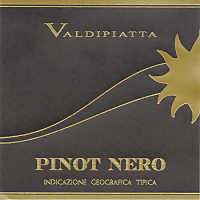
|
|
Pinot Nero 2006 |
|
| Tenuta Valdipiatta (Tuscany, Italy) | |
| Grapes: Pinot Noir | |
| Price: € 23.50 | Score: |
| This Pinot Noir shows a brilliant ruby red color and nuances of garnet red, moderate transparency. The nose reveals intense, clean, pleasing and refined aromas which start with hints of cherry, plum and raspberry followed by aromas of vanilla, dog rose, cyclamen, cocoa, tobacco, menthol and mineral. The mouth has good correspondence to the nose, a slightly tannic attack and however balanced by alcohol, good body, intense flavors, pleasing crispness. The finish is persistent with flavors of cherry, plum and raspberry. This Pinot Noir ages for 12 months in barrique followed by 6 months of aging in bottle. | |
| Food Match: Stuffed pasta, Roasted meat, Stewed meat with mushrooms | |
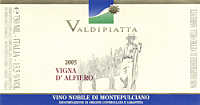
|
|
Vino Nobile di Montepulciano Vigna di Alfiero 2005 |
|
| Tenuta Valdipiatta (Tuscany, Italy) | |
| Grapes: Sangiovese | |
| Price: € 30.00 | Score: |
| Vino Nobile di Montepulciano Vigna di Alfiero shows a brilliant ruby red color and nuances of garnet red, moderate transparency. The nose reveals intense, clean, pleasing, refined and elegant aromas which start with hints of plum, black cherry and violet followed by aromas of blackberry, raspberry, vanilla, tobacco, chocolate, cinnamon, mace and menthol. The mouth has good correspondence to the nose, a tannic attack and however balanced by alcohol, full body, intense flavors, agreeable. The finish is persistent with flavors of plum, black cherry and blueberry. Vino Nobile di Montepulciano Vigna di Alfiero ages for 18 months in barrique followed by 12 months of aging in bottle. | |
| Food Match: Game, Roasted meat, Stewed and braised meat, Hard cheese | |

|
|
Rabià 2005 |
|
| Italo Cescon (Veneto, Italy) | |
| Grapes: Raboso | |
| Price: € 11.50 | Score: |
| Rabià shows a deep ruby red color and nuances of garnet red, little transparency. The nose denotes intense, clean, pleasing and refined aromas which start with hints of black cherry, blackberry and violet followed by aromas of plum, blueberry, vanilla, tobacco, chocolate, licorice and menthol. The mouth has good correspondence to the nose, a tannic attack and pleasing crispness, however balanced by alcohol, good body, intense flavors. The finish is persistent with flavors of black cherry, blackberry and blueberry. Rabià ages for 24 months in cask, 12 months in barrique and 12 months in bottle. | |
| Food Match: Roasted meat, Stewed and braised meat, Hard cheese | |
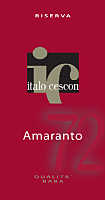
|
|
Amaranto 72 Riserva 2005 |
|
| Italo Cescon (Veneto, Italy) | |
| Grapes: Cabernet Sauvignon (40%), Merlot (35%), Marzemino (10%) | |
| Price: € 19.50 | Score: |
| Amaranto 72 Riserva shows a deep ruby red color and nuances of garnet red, impenetrable to light. The nose reveals intense, clean, pleasing and refined aromas which start with hints of plum, black cherry and black currant followed by aromas of dried violet, tobacco, vanilla, blueberry, chocolate, mace and eucalyptus. The mouth has good correspondence to the nose, a tannic attack and however balanced by alcohol, full body, intense flavors, pleasing roundness. The finish is persistent with flavors of plum, black cherry and black currant. Amaranto 72 Riserva ages for 12 months in barrique, 12 months in cask and for 12 months in bottle. | |
| Food Match: Game, Roasted meat, Braised and stewed meat, Hard cheese | |

|
|
Shiarà 2008 |
|
| Castellucci Miano (Sicily, Italy) | |
| Grapes: Catarratto | |
| Price: € 11.50 | Score: |
| Shiarà shows a pale golden yellow color and nuances of straw yellow, very transparent. The nose reveals intense, clean, pleasing and refined aromas that start with hints of apple, plum and almond followed by aromas of pear, citrus fruits, peach, pineapple, broom and hawthorn. The mouth has good correspondence to the nose, a crisp attack and however balanced by alcohol, good body, intense flavors, pleasing roundness. The finish is persistent with flavors of apple, peach and almond. Shiarà ages for 6 months in steel tanks followed by 4 months of aging in bottle. | |
| Food Match: Roasted fish, White roasted meat, Stuffed pasta | |

|
|
Maravita 2006 |
|
| Castellucci Miano (Sicily, Italy) | |
| Grapes: Perricone | |
| Price: € 25.00 | Score: |
| Maravita shows an intense ruby red color and nuances of ruby red, little transparency. The nose reveals intense, clean, pleasing, refined and elegant aromas that start with hints of black cherry, black berry and plum followed by aromas of dried violet, blueberry, vanilla, tobacco, pink pepper, chocolate, leather and mace. The mouth has good correspondence to the nose, a tannic attack and however balanced by alcohol, good body, intense flavors, agreeable. The finish is persistent with flavors of black cherry, blackberry and plum. Maravita ages for 14 months in barrique followed by 12 months of aging in bottle. | |
| Food Match: Roasted meat, Braised and stewed meat with mushrooms, Hard cheese | |
News |
|
In this section are published news and information about events concerning the world of wine and food. Whoever is interested in publishing this kind of information can send us a mail to our address.
|
AquavitaeReview of Grappa, Distillates and Brandy |
|
|
| Distillates are rated according to DiWineTaste's evaluation method. Please see score legend in the "Wines of the Month" section. |

|
|
Grappa di Amarone 2005 |
|
| Capovilla (Veneto, Italy) | |
| Raw matter: Pomace of Amarone | |
| Price: € 35.00 - 50cl | Score: |
| This grappa is colorless, limpid and crystalline. The nose reveals intense, clean, pleasing, refined and elegant aromas of cherry, violet, plum, raspberry, hazelnut, blackberry and strawberry, with almost imperceptible alcohol pungency. In the mouth has intense flavors with perceptible alcohol pungency which tends to dissolve rapidly, excellent correspondence to the nose, pleasing roundness, very balanced. The finish is very persistent with long flavors of cherry, plum and blackberry. This grappa is double distilled in a water bath discontinuous alembic still. Alcohol 41%. | |
Wine Parade |
|
|
| The best 15 wines according to DiWineTaste's readers. To express your best three wines send us an E-mail or fill in the form available at our WEB site. |
| Rank | Wine, Producer | |
|---|---|---|
| 1 |
| Aglianico del Vulture La Firma 2004, Cantine del Notaio (Italy) |
| 2 |
| Barolo Sorano 2004, Alario (Italy) |
| 3 |
| Sagrantino di Montefalco Passito 2004, Adanti (Italy) |
| 4 |
| Barolo Bussia 2001, Prunotto (Italy) |
| 5 |
| Collio Bianco Col Dis˘re 2004, Russiz Superiore (Italy) |
| 6 |
| Blanc des Rosis 2006, Schiopetto (Italy) |
| 7 |
| Arkezia Muffo di San Sisto 2004, Fazi Battaglia (Italy) |
| 8 |
| Sagrantino di Montefalco 25 Anni 2005, Arnaldo Caprai (Italy) |
| 9 |
| Sagrantino di Montefalco Collepiano 2003, Arnaldo Caprai (Italy) |
| 10 |
| Brunello di Montalcino Progetto Prime Donne 2004, Donatella Cinelli Colombini (Italy) |
| 11 |
| Merlot 2004, Castello delle Regine (Italy) |
| 12 |
| Aglianico del Vulture Il Repertorio 2006, Cantine del Notaio (Italy) |
| 13 |
| Sangiovese di Romagna Superiore Riserva Thea 2005, Tre Monti (Italy) |
| 14 |
| Villa Gresti 2004, Tenuta San Leonardo (Italy) |
| 15 |
| San Leonardo 2001, Tenuta San Leonardo (Italy) |
| |||||||
Privacy Policy | |||||||


| Copyright © 2002-2024 Antonello Biancalana, DiWineTaste - All rights reserved |
| All rights reserved under international copyright conventions. No part of this publication and of this WEB site may be
reproduced or utilized in any form or by any means, electronic or mechanical, without permission in writing from DiWineTaste. |